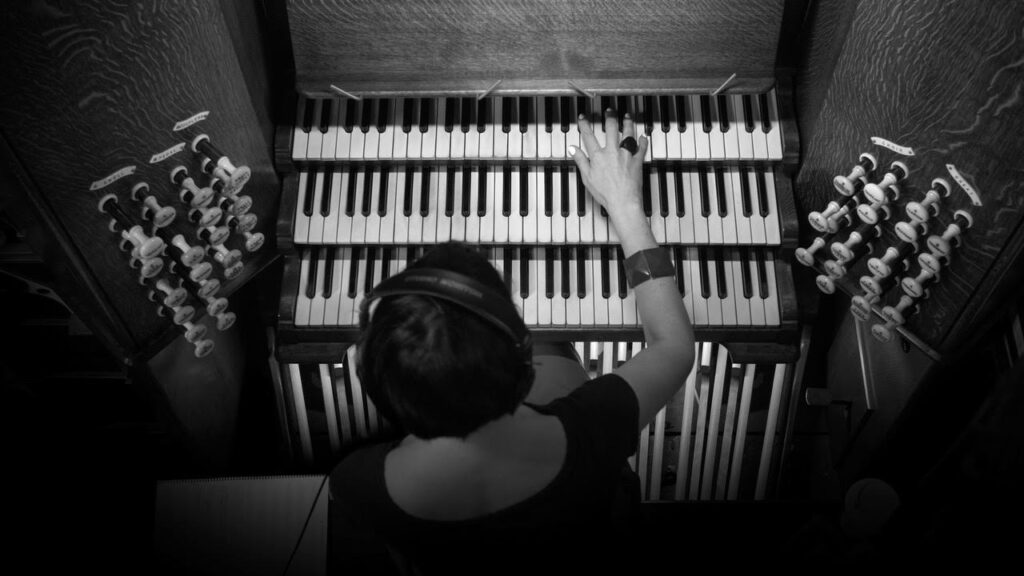Last year, the London-based French composer Angèle David-Guillou released her superb second album, En Mouvement. That record came laced in lush, multi-faceted instrumentation, but now the musician has produced new versions of a selection of tracks, stripped down to just the organ of the Union Chapel.
The new record is titled Mouvements Organiques, and is released today via Village Green Recordings. You can purchase it here
David-Guillou has also been kind enough to share an exclusive track-by-track on the new record, which you can read below.
‘Mouvements Organiques Part One’
When I originally had this record in mind I didn’t anticipate it would sound so ambient. But as I was rehearsing for it, and then recording it, it became apparent that the richness of the frequencies of the organ and the resonance of the Union Chapel church just lent itself to slower music. The room just carries and amplifies the various resonances and, at times, dissonances of the organ in all directions. It’s a very immersive experience, almost like the sound version of looking under water, with rays of light cutting through the surface at unexpected moments, constantly changing the perception of what you see below. You wish you could swim in that sound.
‘En Mouvement’
A couple of years ago, I was lucky enough to be invited to perform the organ for one of Ben Eshmade’s wonderful Daylight Music concerts at the Union Chapel. This is how I got to play this organ for the first time. I later took part in the Organ Reframed festival curated by Claire M. Singer. For both performances I reinterpreted some pieces from my repertoire composed originally for the piano. It was a revelation. Arpeggiating chords – and I have a few of these in my music – create a very specific soundscape when played on a church organ. You really have to play with the room and the decaying of the sounds. It’s very special. Aside from making you feel like the mad organist in Phantom of the Paradise, you can’t help but feel the weight of the history of keyboard music, from pipe organ to Farfisa, from Bach to Philip Glass.
‘Mouvements Organiques Part Two’
I’ve always listened to a lot of ambient music and in the past few years I’ve become quite obsessed with the work of David Behrman, in particular ‘On the Other Ocean’ and ‘Interspecies Smalltalk’. I am very interested in the dialogues he weaves between electronic and acoustic instruments. He manages to create this very soothing sound that is both extremely familiar yet so alien. One of the fascinating aspects of the pipe organ is that it sounds so ancient and so modern at the same time, perhaps because we are now very used to the sound of electronic keyboards. I doubt we can fully grasp the impression it must have made on church goers 400 years ago.
‘Respiro’
This is another rework of a piece from my album En Mouvement, released in October last year. For this specific composition, I normally have the piano sustain pedal pressed down all the way through, as I play with the growing resonance the ostinato arpeggiating left hand creates inside the piano case. With a pipe organ, though you have this huge resonance behind you, the actual sound of the instrument is relatively short and once you lift your finger off the key, the sound stops, you cannot replicate the myriad of touch interpretations you have with a piano. So you have to find other ways of conveying these different emotions. Everything relies on the sounds you choose. I am still working this out, but it seems to me that this is the hardest aspect of playing the organ: the ability to create the right sound.
‘Mouvements Organiques Part Three’
This is the concluding part of ‘Mouvements Organiques’ which was written as one entity. At first I thought it could be released as one long piece, but I liked the idea of having small pauses in between the main composition, as if you were surfacing and breathing in deeply before going back under water once again. Here a melody emerges more distinctively as if leading you further away. Because you have 4 keyboards in total on the organ (including the foot keys which are bloody hard-work), you are allowed the simultaneousness of very different atmospheres and you can, by yourself, create a collision between those different sonic voices. I’m glad I don’t have the space for such an instrument, otherwise I would never leave the house.


